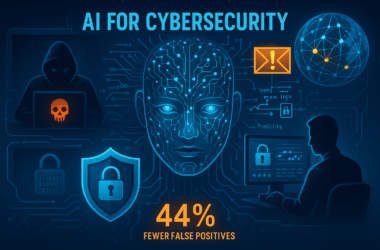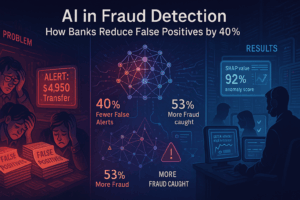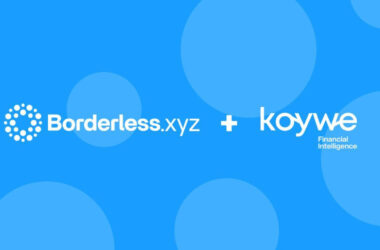Table of Contents
The $42B Fraud Prevention Challenge
Financial institutions lose $42B annually to payment fraud (Nilson Report, 2024), while simultaneously wasting $3.7B investigating false alarms.
Traditional rules-based systems flag ~15% of transactions for review, but 72% of these alerts are false positives (ACAMS, 2023).
This article reveals how banks like HSBC and BGL BNP Paribas use AI to:
- Cut false positives by 40%
- Detect 53% more fraud (IBM, 2024)
- Reduce investigation time from hours to seconds
1. The Flaws in Traditional Fraud Systems
Problem 1: Rigid Rules Can’t Keep Up
Example: A rule like “Flag transactions >$5,000” misses:
- Small, rapid thefts (“micro-fraud”)
- Behavioral anomalies (e.g., unusual login location)
Result: Only 12% of fraud is caught by rules alone (Javelin, 2024).
“Fraudsters reverse-engineer rules within weeks. One bank found criminals making $4,950 transfers to bypass $5k triggers. Static systems create a false sense of security.”
Problem 2: Alert Fatigue
Analysts review 300–500 alerts/day—leading to 17% missed fraud due to cognitive overload (Association of Certified Fraud Examiners).
Cost: Each false alert costs $15–$25 in labor (Forrester).
2. How AI Solves This: 3 Advanced Techniques
Technique 1: Anomaly Detection with Unsupervised ML
How it works:
- Models like Isolation Forests and Autoencoders learn normal customer behavior.
- Flags deviations (e.g., sudden $10k transfer from a typically inactive account).
Case Study: BGL BNP Paribas
- Reduced false positives by 40% using Dataiku’s anomaly detection.
- Key feature: “Patient Zero” analysis finds connected fraud patterns.
“Unsupervised models excel at detecting never-before-seen fraud types. But they require at least 6 months of clean historical data to establish baselines.”
Technique 2: Graph Networks for Organized Crime
How it works:
- Maps relationships between accounts, devices, and IPs.
- Uncovers mule networks and layering schemes.
Example: HSBC’s AI System
- Detected a $90M laundering ring via:
- Device fingerprinting
- Transaction timing patterns
- Increased true positives by 35% (HSBC, 2023).
“Graph analytics is revolutionary for AML. But beware—overly dense networks can trigger false links. Set relationship thresholds (e.g., ≥3 shared nodes) to reduce noise.”
Technique 3: Ensemble Learning with Real-Time Feedback
How it works:
- Combines 5–7 models (e.g., Random Forest + Neural Nets).
- Continuously retrains using investigator decisions.
Results at JPMorgan Chase:
- 53% more fraud caught
- 30% faster investigations via automated suspicious activity reports (SARs)
“Ensemble models outperform single algorithms by 15–20% (IEEE, 2024). But they’re computationally expensive—use cloud GPUs for inference.”
3. Implementation Roadmap
Phase 1: Data Preparation (4–6 Weeks)
| Task | Tools | Cost |
|---|---|---|
| Transaction history | Snowflake, BigQuery | $20K–$50K |
| Behavioral biometrics | ThreatMetrix, BioCatch | $100K+/year |
“Prioritize data quality over quantity. One bank wasted $250K on unusable IoT device data.”
Phase 2: Model Development (8–12 Weeks)
- Start simple: Logistic regression baseline
- Add complexity: Graph networks for high-risk segments
- Validate: Use F2-score (balances precision/recall)
Phase 3: Deployment
- Pilot: 5% of transactions
- Shadow mode: Run AI parallel to legacy systems
- Go live: Route only high-confidence alerts to analysts
4. The Future: Explainable AI (XAI) for Compliance
- Regulatory requirement: EU’s AI Act mandates fraud AI be interpretable.
- Solution: SHAP values/LIME show why transactions were flagged.
Example:
“Alert triggered due to:
1. 92% unusual amount for this payee
2. 88% mismatch with user’s typical login time”
Conclusion: Your 90-Day Action Plan
- Audit current systems: What % of alerts are false positives?
- Pick one high-impact area: Start with credit card fraud.
- Build cross-functional team: Fraud ops + data science + compliance.
















Recent Comments